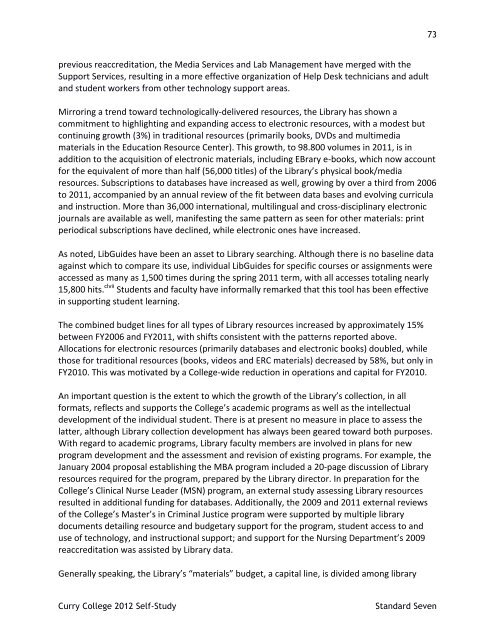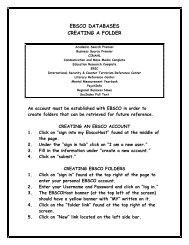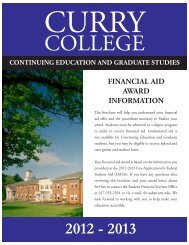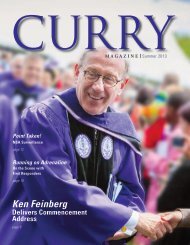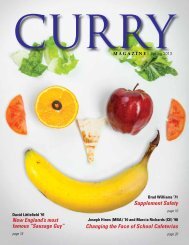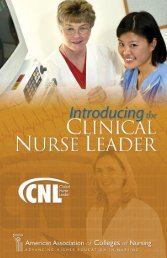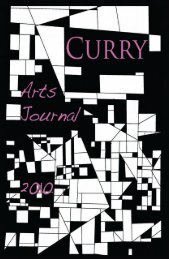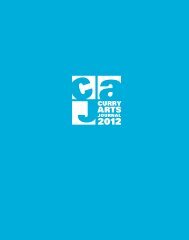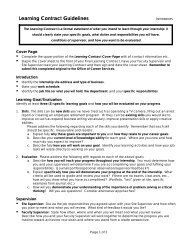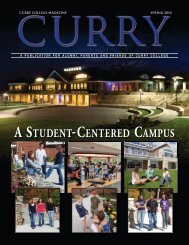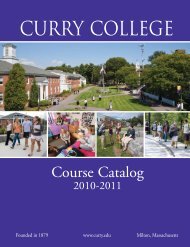Read the Curry College NEASC 2012 Self-Study Report.
Read the Curry College NEASC 2012 Self-Study Report.
Read the Curry College NEASC 2012 Self-Study Report.
You also want an ePaper? Increase the reach of your titles
YUMPU automatically turns print PDFs into web optimized ePapers that Google loves.
73<br />
previous reaccreditation, <strong>the</strong> Media Services and Lab Management have merged with <strong>the</strong><br />
Support Services, resulting in a more effective organization of Help Desk technicians and adult<br />
and student workers from o<strong>the</strong>r technology support areas.<br />
Mirroring a trend toward technologically‐delivered resources, <strong>the</strong> Library has shown a<br />
commitment to highlighting and expanding access to electronic resources, with a modest but<br />
continuing growth (3%) in traditional resources (primarily books, DVDs and multimedia<br />
materials in <strong>the</strong> Education Resource Center). This growth, to 98.800 volumes in 2011, is in<br />
addition to <strong>the</strong> acquisition of electronic materials, including EBrary e‐books, which now account<br />
for <strong>the</strong> equivalent of more than half (56,000 titles) of <strong>the</strong> Library’s physical book/media<br />
resources. Subscriptions to databases have increased as well, growing by over a third from 2006<br />
to 2011, accompanied by an annual review of <strong>the</strong> fit between data bases and evolving curricula<br />
and instruction. More than 36,000 international, multilingual and cross‐disciplinary electronic<br />
journals are available as well, manifesting <strong>the</strong> same pattern as seen for o<strong>the</strong>r materials: print<br />
periodical subscriptions have declined, while electronic ones have increased.<br />
As noted, LibGuides have been an asset to Library searching. Although <strong>the</strong>re is no baseline data<br />
against which to compare its use, individual LibGuides for specific courses or assignments were<br />
accessed as many as 1,500 times during <strong>the</strong> spring 2011 term, with all accesses totaling nearly<br />
15,800 hits. clvii Students and faculty have informally remarked that this tool has been effective<br />
in supporting student learning.<br />
The combined budget lines for all types of Library resources increased by approximately 15%<br />
between FY2006 and FY2011, with shifts consistent with <strong>the</strong> patterns reported above.<br />
Allocations for electronic resources (primarily databases and electronic books) doubled, while<br />
those for traditional resources (books, videos and ERC materials) decreased by 58%, but only in<br />
FY2010. This was motivated by a <strong>College</strong>‐wide reduction in operations and capital for FY2010.<br />
An important question is <strong>the</strong> extent to which <strong>the</strong> growth of <strong>the</strong> Library’s collection, in all<br />
formats, reflects and supports <strong>the</strong> <strong>College</strong>’s academic programs as well as <strong>the</strong> intellectual<br />
development of <strong>the</strong> individual student. There is at present no measure in place to assess <strong>the</strong><br />
latter, although Library collection development has always been geared toward both purposes.<br />
With regard to academic programs, Library faculty members are involved in plans for new<br />
program development and <strong>the</strong> assessment and revision of existing programs. For example, <strong>the</strong><br />
January 2004 proposal establishing <strong>the</strong> MBA program included a 20‐page discussion of Library<br />
resources required for <strong>the</strong> program, prepared by <strong>the</strong> Library director. In preparation for <strong>the</strong><br />
<strong>College</strong>’s Clinical Nurse Leader (MSN) program, an external study assessing Library resources<br />
resulted in additional funding for databases. Additionally, <strong>the</strong> 2009 and 2011 external reviews<br />
of <strong>the</strong> <strong>College</strong>’s Master’s in Criminal Justice program were supported by multiple library<br />
documents detailing resource and budgetary support for <strong>the</strong> program, student access to and<br />
use of technology, and instructional support; and support for <strong>the</strong> Nursing Department’s 2009<br />
reaccreditation was assisted by Library data.<br />
Generally speaking, <strong>the</strong> Library’s “materials” budget, a capital line, is divided among library<br />
<strong>Curry</strong> <strong>College</strong> <strong>2012</strong> <strong>Self</strong>-<strong>Study</strong><br />
Standard Seven


